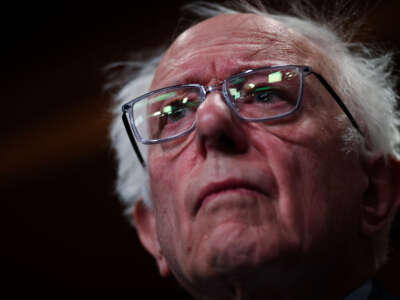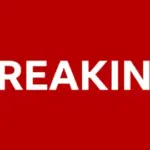At Nasser Hospital in Khan Younis, Taghreed al-Attar sits next to her husband’s body, which was discovered last Friday in Rafah. Her husband, Anwar al-Attar, left with fellow first responders to Rafah the previous week, but no one returned.
His wife says that when they lost contact with him, people told her he had been imprisoned by the Israeli army. But she says he came to her in a dream, and she saw him in paradise surrounded by rivers and fruit. She couldn’t believe he was a prisoner.
“He never missed work for a moment since the war began. He was injured three times, and everyone asked him to stop working and take a rest,” Taghreed says in a video testimony to Mondoweiss. “But he always said he needed to be a role model for his colleagues and would never stop working and providing services to his people. He risked his life, entering the rubble and extracting martyrs. I am proud of him and hope our children will be like him.”
She notes that he always talked to her about the dangers he faced, sometimes telling her that quadcopter drones always chased after them and sometimes fired on them. She would ask him if he was scared, and he would tell her that God was with him.
“Anwar has three daughters, the youngest of whom is four,” his wife says.
Al-Attar had been dispatched with his Civil Defense colleagues last week on a mission to rescue a team of paramedics with the Palestinian Red Crescent Society (PRCS) who had gone missing, only to have contact with him and the rescue team severed as well.
Anwar’s body was found buried in the sand a few days later. This was the first sign of evidence that the Israeli army had targeted Civil Defense and PRCS crews in Rafah, a Civil Defense spokesperson told Mondoweiss.
A few days after finding the body of al-Attar, Civil Defense teams that had been digging in the area after being granted permission by the Israeli army found 14 dead bodies.
The Gaza Ministry of Health said in a statement on March 30 that the bodies belonged to 8 paramedics from PRCS, 5 members of the Civil Defense, and one person whose identity remains unknown. The statement said that the crews had been “executed” and “some were found with their hands bound.”
The Ministry added that the bodies of the first responder teams showed signs of being deliberately targeted. “Some of them were shot in the head and chest, and they were buried in deep holes to prevent them from being found,” the Ministry said.
At the funeral of al-Attar last week, Civil Defense members bidding farewell to their fallen colleague with tears in their eyes told Mondoweiss via video testimony about al-Attar’s dedication to his work. “He was carrying out humanitarian work throughout the war, and his mission was to retrieve the wounded and the martyrs from the rubble,” said Abdul Rahman Ashour, one of the Civil Defense members who recovered al-Attar’s body from Rafah.
“Anwar’s vest and helmet, which mark him as a Civil Defence Worker, were punctured by over 20 bullet holes,” Ashour told Mondoweiss. “He was shot in the head and chest, and in the lower part of his body. He was brutally murdered.”
The PRCS ambulance that had been sent to Rafah to answer distress calls had caught fire after being fired upon by the Israeli army, Ashour said. That was when al-Attar and his crew were dispatched, leaving with a fire engine and another ambulance in tow.
“The ambulance and fire crews were directly targeted,” Ashour added, saying that al-Attar and his colleagues were “executed in the field.”
How the Massacre of First Responders Unfolded
Over the past week, the Israeli army raided various areas in the Gaza Strip, including the Tal al-Sultan neighborhood in Rafah, specifically an area to the west part commonly known as “al-Baraksat.” During the first days of the raid, residents shared horrific stories of mass executions, young men being rounded up in ditches and shot at point-blank range, and children being killed in front of their mothers.
Several survivors who managed to leave the area repeated these claims to Mondoweiss, but Mondoweiss was unable to verify them at the time given that no first responders were allowed to reach the area as a result of the tight blockade imposed by the Israeli army. Since then, more and more testimonies have emerged from survivors and first responders who came from the area.
Marwan al-Hams, director of field hospitals in Gaza, told Mondoweiss via video testimony that they had been receiving reports of “many bodies and body parts” being found in Rafah. “They are the remains of a group of martyrs,” he said. “People tried to retrieve them but were unable to. They just covered them with sand to keep them from being eaten by stray dogs.”
It was in this context that civilians trapped in Tal al-Sultan sent out distress calls to the PRCS and Civil Defense in the Rafah area last week. Two vehicles were dispatched, and when they disappeared, the two vehicles led by Anwar al-Attar went after them.
The fate of all the crews remained unknown for over a week. During this period, the PRCS and Civil Defense attempted to obtain coordination permission from the Israeli army to enter Rafah to search for their missing colleagues.
Mahmoud Basal, a Civil Defense spokesperson in the Gaza Strip, recounts that as soon as Attar’s team had arrived in Rafah, the Israeli army closed the entrances and exits to Rafah, effectively besieging the first responders. That was when communications were lost, Basal says.
“We demanded that international organizations and the international community help us to coordinate with the occupation to be allowed entry into the area, so we could know the fate of our crews,” Basal tells Mondoweiss. “Over several days, we attempted to coordinate, but the occupation categorically refused.”
After numerous requests, the Civil Defense, the Red Crescent, and the UN Office for the Coordination of Humanitarian Affairs (OCHA) obtained coordination from the occupation on March 27.
“We entered Rafah after much suffering, only to be surprised by the scale of the massacre that had taken place there,” Basal says. “The occupation forces opened heavy fire on Red Crescent and Civil Defense vehicles. Israeli bulldozers even placed sand barriers over the area [where they were buried], completely altering its features.”
“All indications at the scene show that the Israeli occupation forces executed the medical crews,” Basal continues, adding that during search efforts on March 27, the teams identified the body of Anwar al-Attar. “We tried to locate the others, but darkness fell and prevented us from completing the search.”
Three days later, the Civil Defense teams found the rest of the missing crews — 14 people found buried, some with their hands bound and showing signs of being shot in the head and chest.
Civil Defense and Red Crescent crews enjoy international immunity and are protected by international humanitarian law, Basal points out.
“But unfortunately, the occupation has clear experience with killings. We are talking about 105 civil defense martyrs, all of whom had immunity, but the occupation killed them,” Basal says. “This demonstrates that the occupation has no red lines and does not abide by international or humanitarian law.”
An Israeli army statement to AFP said that “a few minutes” after soldiers “eliminated several Hamas terrorists” by opening fire on their vehicles, “additional vehicles advanced suspiciously toward the troops.” The statement added that the army had shot “toward the suspicious vehicles, eliminating a number of Hamas and Islamic Jihad terrorists.”
The army admitted that an initial inquiry revealed that “some” of the vehicles were ambulances and fire trucks, adding that the army condemns the use of such vehicles by “terrorist organizations” for “terrorist purposes.”
Mahmoud Basal denies these allegations, saying that the occupation wanted to cover up the crime by claiming that they were fighters from Hamas and Islamic Jihad. He says that the Civil Defense holds the Israeli occupation fully responsible for killing the crews, violating international humanitarian law, and committing a massacre against medical personnel and first responders, who are distinguished by their orange vests.
“This vest is coordinated with the Israeli occupation,” Basal says. “The entry operation [of the rescue teams into Rafah] was clear, but the occupation committed the massacre and now wants to escape embarrassment.”
“What happened to our crews is a full-fledged massacre and a crime for which the occupation must be held accountable by the free world and humanitarian organizations,” Basal added. “This has serious repercussions, and the world must realize that what happened in Gaza is a flagrant violation of international humanitarian law.”
We’re not backing down in the face of Trump’s threats.
As Donald Trump is inaugurated a second time, independent media organizations are faced with urgent mandates: Tell the truth more loudly than ever before. Do that work even as our standard modes of distribution (such as social media platforms) are being manipulated and curtailed by forces of fascist repression and ruthless capitalism. Do that work even as journalism and journalists face targeted attacks, including from the government itself. And do that work in community, never forgetting that we’re not shouting into a faceless void – we’re reaching out to real people amid a life-threatening political climate.
Our task is formidable, and it requires us to ground ourselves in our principles, remind ourselves of our utility, dig in and commit.
As a dizzying number of corporate news organizations – either through need or greed – rush to implement new ways to further monetize their content, and others acquiesce to Trump’s wishes, now is a time for movement media-makers to double down on community-first models.
At Truthout, we are reaffirming our commitments on this front: We won’t run ads or have a paywall because we believe that everyone should have access to information, and that access should exist without barriers and free of distractions from craven corporate interests. We recognize the implications for democracy when information-seekers click a link only to find the article trapped behind a paywall or buried on a page with dozens of invasive ads. The laws of capitalism dictate an unending increase in monetization, and much of the media simply follows those laws. Truthout and many of our peers are dedicating ourselves to following other paths – a commitment which feels vital in a moment when corporations are evermore overtly embedded in government.
Over 80 percent of Truthout‘s funding comes from small individual donations from our community of readers, and the remaining 20 percent comes from a handful of social justice-oriented foundations. Over a third of our total budget is supported by recurring monthly donors, many of whom give because they want to help us keep Truthout barrier-free for everyone.
You can help by giving today. Whether you can make a small monthly donation or a larger gift, Truthout only works with your support.
Read full article at source
Stay informed about this story by subscribing to our regular Newsletter


